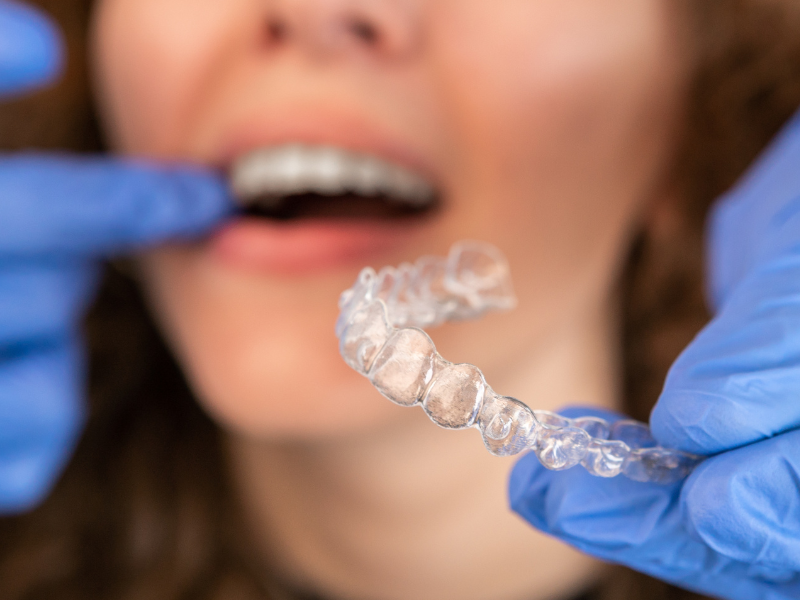Invisalign Pros and Cons for Older Adults
Invisalign is a popular choice for older adults looking to straighten their teeth discreetly and comfortably. This innovative orthodontic treatment offers several advantages, such as improved oral hygiene due to the removability of the aligners and fewer orthodontist visits. However, it's essential to consider the challenges, such as the need for disciplined wear and the potential for dry mouth and bad breath. Consulting with an orthodontist who can provide personalized advice based on your specific dental situation is always a wise step in deciding if Invisalign is the right choice for you.
Key Takeaways: Invisalign for Older Adults
- Invisalign offers comfort, aesthetics, removability, and improved oral hygiene, making it a popular choice for older adults.
-
Challenges of Invisalign include discipline and compliance, temporary speech changes, and cost considerations.
-
After Invisalign treatment, wearing a retainer is essential to maintain the results and prevent teeth from shifting back to their original position.
In our quest for a radiant smile, Invisalign has emerged as a worthwhile option, especially for the ever-growing number of older adults who wish to straighten their teeth discreetly and comfortably. Let's explore the benefits of Invisalign and the challenges you may face along the way.
Why Invisalign Is a Popular Choice for Older Adults

Comfort and Aesthetics
For many older adults, the thought of metal braces can be off-putting, not just for aesthetic reasons but also due to comfort concerns. Invisalign aligners fit snugly around your teeth, significantly reducing discomfort and the risk of gum irritation. Unlike traditional braces, these clear aligners are virtually invisible, offering a level of discretion that allows you to smile confidently throughout your treatment.
Removability and Oral Hygiene
One of the most significant advantages of Invisalign aligners is their removability. This feature is particularly beneficial for older adults, who may be more susceptible to gum disease and tooth decay. With the ability to remove the aligners, you can maintain better oral hygiene by thoroughly brushing and flossing to keep your teeth healthy. Also, you can continue to enjoy your favorite foods without the dietary restrictions often associated with traditional metal braces.
Less Frequent Orthodontist Visits
Time is precious, and for older adults who may have a busy schedule or limited mobility, the fewer orthodontist visits required with Invisalign treatment are a welcome relief. Since Invisalign trays are replaced every few weeks, most patients enjoy the convenience of less frequent check-ups, which also means more time to enjoy the things that matter most to you.
Common Challenges for Older Adults Using Invisalign
Discipline and Compliance
While the removability of Invisalign aligners is a pro, it also demands a high level of discipline and compliance. For the treatment to be effective, aligners must be worn for at least 22 hours a day. As an older adult, it's important to commit to this regimen to guarantee the success of your treatment. It may take a bit of getting used to, but the results are worth the effort.
Speech Changes and Mouth Sores
Adapting to Invisalign can sometimes result in temporary speech changes, with some people experiencing a slight lisp until they adjust to the aligners. In addition, the edges of the trays may cause mouth sores, although this is less common than with traditional braces. If you encounter these issues, rest assured they typically resolve as you become more accustomed to wearing your aligners.
Cost Considerations
Investing in Invisalign treatment is a financial commitment, and it's important to consider the cost implications. While the price range for clear aligners is generally comparable to that of traditional metal or ceramic braces, it's essential to evaluate your budget and discuss payment options with your orthodontist. Remember, the investment is not just in straightening teeth but in the better oral health and confidence that comes with a beautiful smile.
Dealing with Dry Mouth and Bad Breath: Introducing Movemints

Dry mouth and bad breath can be uncomfortable side effects of wearing Invisalign aligners, as they can restrict natural saliva flow. However, there is a refreshing solution: Movemints. These sugar-free mints, designed specifically for clear aligner users, serve a dual purpose. Not only do they freshen breath, but they also help to seat the aligners properly, ensuring a snug fit and promoting effective tooth movement. Plus, with the added benefits of xylitol, these mints help combat dry mouth while being safe for your teeth.
Invisalign Aftercare: The Importance of Retainers
After straightening your teeth with Invisalign, wearing a retainer is essential to maintain those results and prevent a relapse, where teeth might shift back to their original position. Your orthodontist will advise you on the frequency and duration of wearing your retainer, typically starting every night and gradually reducing over time.
Frequently Asked Questions
Is Invisalign worth it for older adults?
Certainly! Invisalign treatments have significant benefits for adult patients, aiming to enhance their smile and oral health. It's appreciated for its comfort, aesthetic appeal, and ease of maintaining oral hygiene. The convenience of fewer orthodontist visits and the flexibility in diet are also compelling reasons to choose Invisalign.
What age is too late for Invisalign?
There is no definitive age limit for Invisalign. Orthodontic treatments can be successful at any age, as long as the gums and teeth are healthy. Older adults often appreciate the discreet nature of Invisalign, and with advances in orthodontic technology, age has become less of a barrier to achieving straight teeth. It's always best to discuss this with an orthodontist to evaluate your specific circumstances and dental health.



